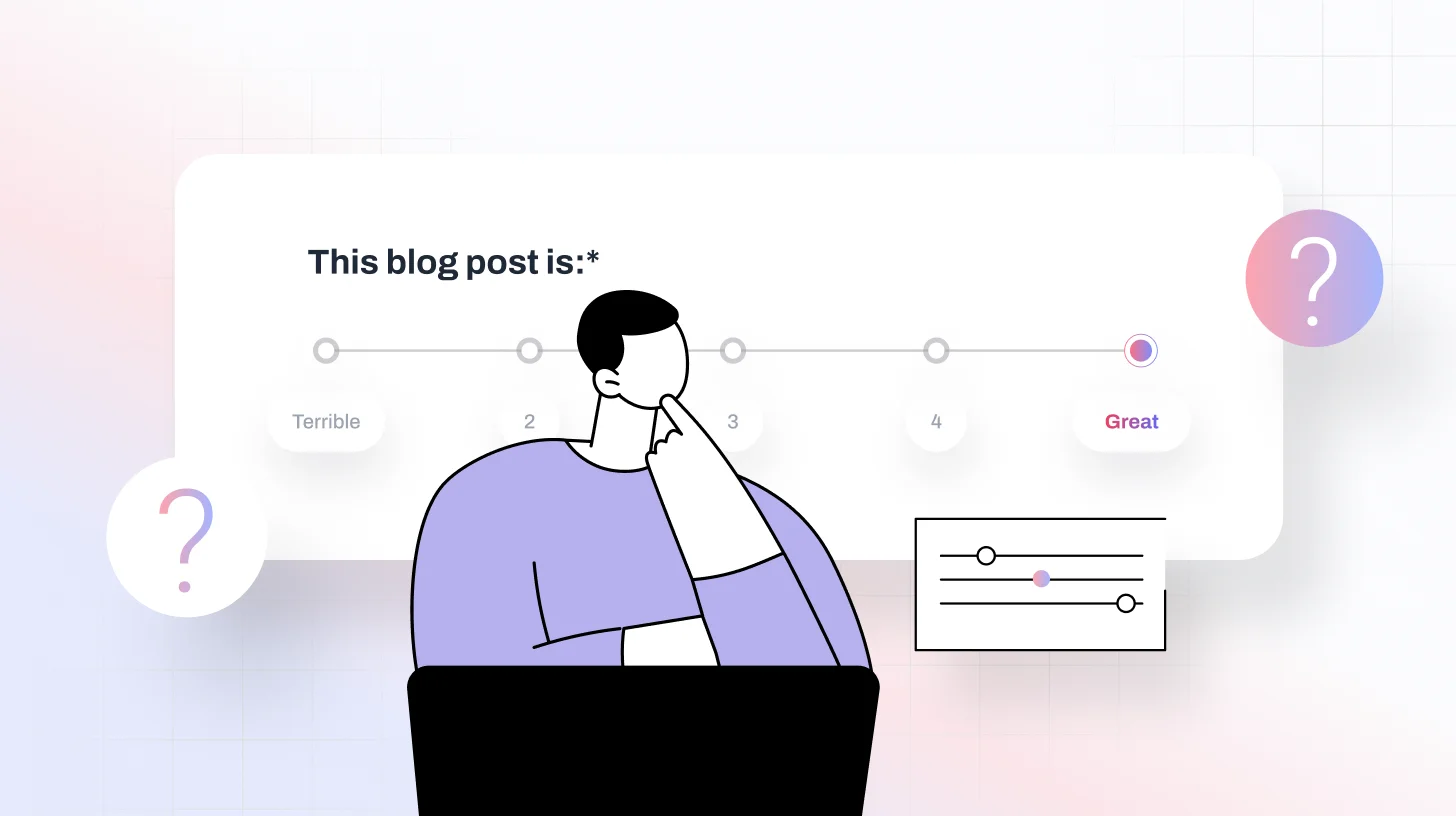 Blog
Blog How AI Surveys Streamline Creation and Improve Data Quality
How AI Surveys Streamline Creation and Improve Data QualityHow AI Surveys Streamline Creation and Improve Data Quality

Building surveys that actually work feels impossible sometimes. You spend days crafting questions, testing logic flows, and praying people will complete them. Then the responses come back messy, incomplete, or just plain confusing. AI surveys change this entire headache.
Smart automation handles the heavy lifting. Quality control happens automatically. Data comes back cleaner and more useful than anything you've seen from traditional methods.
This guide shows you exactly how these smart tools eliminate creation bottlenecks and deliver higher-quality data. You'll learn which specific problems AI solves, see real examples of quality improvements, and discover how to implement AI surveys without technical headaches.
Survey Creation Used to Be a Time Sink
Creating surveys manually drains your energy fast through these common problems:
- Question writing takes forever because you're never sure if the wording makes sense
- Logic branching becomes a puzzle that hurts your brain
- Testing every possible path through your survey feels like debugging code
- Mobile compatibility issues pop up randomly during formatting
- Skip patterns break when you're not looking, creating survey flow problems
- 10-minute surveys somehow become 25-minute monsters that scare people away
- Email deliverability problems complicate distribution efforts
- Broken links and response tracking across multiple channels create headaches
- Technical problem management takes time away from focusing on getting good feedback
The manual survey creation process forces you to become a part-time web developer instead of a feedback strategist. You end up fixing technical issues rather than designing questions that actually help your business.
AI Handles Survey Creation Automatically
Modern AI technology eliminates most creation pain points through smart automation. The technology analyzes your goals and builds appropriate question sets without manual intervention.
AI-powered survey generation starts with understanding what you want to learn. Feed the system basic information about your research objectives, and it suggests relevant question types, optimal survey length, and logical flow patterns.
Question optimization happens behind the scenes. Automated survey design reviews question clarity, checks for leading language, and suggests improvements based on response pattern analysis from thousands of previous surveys.
Logic branching gets built automatically. Complex skip patterns that used to take hours to map now generate instantly. The system ensures every possible response path works correctly before launch.
Mobile optimization comes standard. These smart systems automatically format for different screen sizes, test loading speeds, and adjust question layouts for better mobile completion rates.
Use Case #1: Customer Satisfaction Survey
A restaurant chain needs customer feedback about their new menu items. Instead of spending weeks writing questions, they tell the AI: "We want to understand customer reactions to our new healthy menu options and identify improvement opportunities."
The system automatically generates:
- Opening questions about recent dining experience and menu familiarity
- Product-specific inquiries about taste, portion size, and value perception for new items
- Comparison questions between new and existing menu options
- Open-ended prompts for detailed feedback and suggestions
- Demographic questions positioned at the end to maintain engagement
The entire survey gets built in 15 minutes instead of 15 hours, complete with mobile formatting and logic that shows relevant questions based on which items customers actually ordered.
Data Quality Problems Disappear
Traditional surveys produce messy data that requires extensive cleanup. Response validation happens after collection, when problems are harder to fix. Smart survey systems prevent quality issues during collection instead of trying to solve them later.
Real-time response validation catches problems immediately. Someone provides an obviously fake email address? The system prompts for correction before moving forward. Inconsistent answers trigger clarification requests automatically.
Intelligent survey tools detect suspicious response patterns as they happen. Extremely fast completion times, repetitive answer patterns, or nonsensical open-ended responses get flagged for review.
Response completeness improves dramatically. These intelligent systems identify when someone seems confused or frustrated and offer help or clarification. Incomplete responses drop because the system guides people through difficult sections.
Open-ended response quality gets better through machine learning in survey creation. The AI prompts for more detail when answers seem too brief or asks follow-up questions that encourage thoughtful responses.
Use Case #2: Employee Engagement Survey
A software company launches an employee satisfaction survey and notices concerning response patterns. Traditional surveys would catch these issues weeks later during analysis. AI surveys spot problems immediately: one respondent completes a 20-question survey in 30 seconds, another provides identical ratings across all categories.
The system automatically flags these responses, prompts the rushed respondent to review their answers, and asks the repetitive respondent for clarification. Result: cleaner data and more reliable insights without manual intervention.
Processing Speed Changes Everything
Manual data processing creates weeks of delay between collection and insights. Smart automated systems analyze responses as they arrive, providing immediate feedback about emerging patterns.
AI-driven data collection generates automatic summaries while your survey is still live. Spot concerning trends early and adjust distribution strategies if needed. See which questions perform well and which ones confuse respondents.
Coding open-ended responses happens instantly instead of taking days or weeks. AI surveys categorize qualitative feedback, identify sentiment patterns, and extract key themes without human intervention.
Statistical analysis runs automatically. Cross-tabulations, significance testing, and correlation analysis generate without manual setup. Your team gets sophisticated analytics without requiring specialized statistical knowledge.
Report generation becomes push-button simple. These automated tools create visualizations, write summary findings, and identify actionable recommendations based on your data.
Read - Student Satisfaction Survey Guide: Questions, Tips, and Free Template
Use Case #3: Product Launch Feedback
A tech startup collects feedback on their new mobile app feature. Traditional processing would take 2-3 weeks for manual coding and analysis. With AI automation, patterns emerge within hours: 67% mention "confusing navigation," sentiment analysis reveals frustration themes, and statistical correlations show the navigation issue specifically impacts users over 45. The startup pushes a navigation update within 48 hours instead of waiting weeks for insights, preventing negative reviews and user churn.
Different Industries See Specific Benefits

Software Companies: Product feedback gets more detailed when AI surveys probe specific feature usage patterns. Bug reports include relevant technical details automatically extracted from user responses.
Retail Businesses: Customer satisfaction data becomes more actionable when surveys connect feedback to purchase history, product categories, and seasonal trends.
Healthcare Organizations: Patient experience surveys yield better insights when AI surveys adapt questions based on treatment types, appointment outcomes, and care pathway differences.
Educational Institutions: Student feedback provides more useful information when surveys account for course difficulty, instructor experience, and learning format variations.
Quality Control Happens Continuously
Traditional surveys rely on post-collection data cleaning that catches problems too late. AI surveys monitor quality continuously throughout the collection period.
Response consistency gets checked in real-time. Someone rates overall satisfaction as "very high" but complains extensively in open-ended sections? The system flags the inconsistency and asks for clarification.
Completion patterns reveal survey problems early. If abandonment spikes at specific questions, AI alerts you immediately so you can investigate and potentially make adjustments.
Advanced survey technology detects when respondents seem confused or frustrated based on response timing, revision patterns, and help-seeking behavior. Quality issues get addressed before they impact your data.
Duplicate responses get identified automatically. AI systems recognize when the same person attempts to complete your survey multiple times and handles the situation appropriately.
Real-Time Insights Enable Quick Action
These surveys provide insights while data collection is still active, enabling immediate response to emerging issues.
Customer complaints surface immediately through automated sentiment analysis. Serious problems get escalated to appropriate team members within hours instead of weeks.
Positive feedback gets identified quickly too. Strong product endorsements or service praise can inform marketing efforts while the sentiment is still fresh.
Real-time survey optimization adjusts question ordering, timing, and distribution based on response patterns. Poor-performing elements get modified or replaced automatically.
Sample composition monitoring ensures you're getting responses from your target audience. Demographic skews or selection bias issues get detected early.
Our Approach to Smart Survey Creation
TheySaid's AI surveys tackle both creation efficiency and data quality through integrated automation. Our system learns about your organization from existing documents and creates contextually relevant surveys automatically.
Industry-specific question libraries mean your surveys use appropriate terminology and address relevant concerns without manual customization. A healthcare survey feels different from a retail survey because the AI understands sector-specific priorities.
Survey automation software handles distribution optimization by analyzing when your audience is most likely to respond based on historical patterns and engagement data.
Response quality gets monitored through conversation depth analysis. Our surveys encourage deeper engagement by asking natural follow-up questions that feel conversational rather than robotic.

Getting Started with Quality-Focused Surveys
Transitioning to AI powered surveys doesn't require technical expertise or major process changes. Modern platforms handle complexity behind the scenes while providing familiar interfaces.
Start with simple feedback collection scenarios to test AI capabilities. Employee satisfaction surveys or customer service feedback work well for initial testing.
Quality improvements become obvious quickly. Response rates increase, data requires less cleanup, and insights arrive faster than traditional methods.
Team training needs are minimal. AI surveys are designed to be intuitive for non-technical users while providing sophisticated capabilities when needed.
Sign up and upgrade your feedback collection system with TheySaid today.
Key Takeaways
- Implement automated survey creation - reduce question writing time from days to hours while improving clarity and flow
- Use real-time quality monitoring - catch data problems during collection instead of discovering them weeks later during analysis
- Leverage automatic response validation - ensure higher quality data by validating answers as respondents provide them
- Focus on industry-specific customization - get better insights with surveys tailored to your sector's unique requirements
- Enable continuous insights delivery - receive actionable feedback while surveys are active rather than waiting for completion
AI-powered surveys represent a fundamental shift from reactive data cleaning to proactive quality assurance. Traditional survey methods create delays and quality problems that AI prevents entirely. Organizations implementing these technologies gain competitive advantages through faster insights, better response rates, and cleaner data that drives more confident decision-making.
Frequently Asked Questions
Q: How do AI ensure better data quality than traditional methods?
A: AI surveys validate responses in real-time, detect inconsistencies immediately, and prompt for clarification when answers seem incomplete or contradictory, preventing quality issues rather than fixing them later.
Q: What makes AI survey creation faster than manual survey building?
A: Automated survey design generates questions, logic flows, and formatting automatically based on research objectives, eliminating hours of manual work while ensuring best practices.
Q: Can AI adapt to different industries automatically?
A: Yes, intelligent survey tools use industry-specific question libraries and terminology databases to create contextually appropriate surveys without manual customization.
Q: How quickly can AI-powered surveys provide actionable insights?
A: AI-driven data collection analyzes responses as they arrive, providing immediate trend identification and automated reporting rather than waiting weeks for manual analysis.
Q: Do AI-powered surveys require technical expertise to implement and manage?
A: Modern smart surveys are designed for non-technical users, providing sophisticated automation through intuitive interfaces that require minimal training or technical knowledge.















.svg)